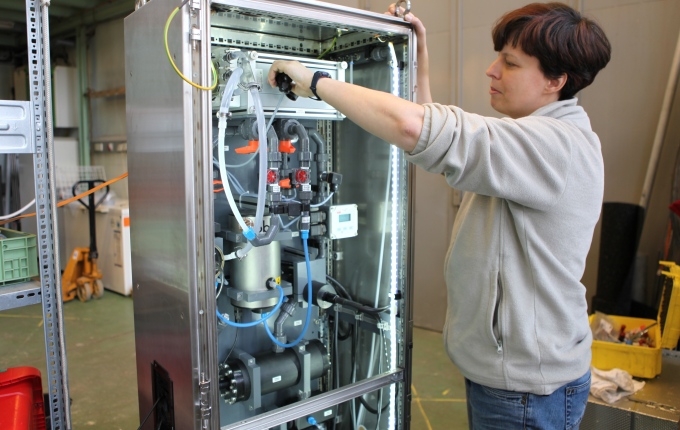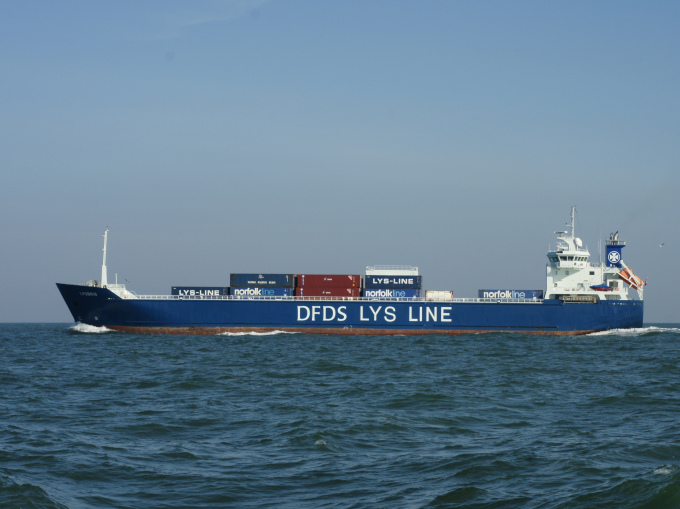Ferries now ten years in the service of science: How FerryBoxes explore the oceans
The idea is a stroke of genius: ships that operate on fixed routes are equipped with measuring systems to investigate the marine environment. Scientists from the Institute of Coastal Research at the Helmholtz-Zentrum Geesthacht have put this idea into practice. Measuring systems are installed in boxes - so-called FerryBoxes. A marketable product has been developed in cooperation with the company 4H JENA. Meanwhile 33 of these FerryBoxes are in operation worldwide – from Spitsbergen to the Antarctic. The most recent purchase of one of these measuring systems was by the Brazilian oil firm Petrobras, in order to monitor the quality of water around its oil platforms.

A new FerryBox is in preparation at the Helmholtz-Zentrum Geesthacht for the installation on a cargo ship Photo: HZG/ Heidrun Hillen
A great deal of time and money can be saved if autonomous measuring devices for the monitoring of water quality are installed on vessels with fixed routes. These are primarily ferries and cargo ships.
Working in cooperation with other European scientists, coastal research scientists at the Helmholtz-Zentrum Geesthacht (HZG) have taken up this idea and developed the FerryBox system. The first FerryBox was installed ten years ago on the ferry operating between Hamburg and Harwich (England).
The company 4H Jena has worked with these scientists to develop the system into a marketable product. The Box is equipped with different instruments depending on the field of interest and particular requirements: from a thermometer, to devices for monitoring algal growth, to pH sensors for the measurement of ocean acidification.
A FerryBox costs between 60,000 and 100,000 euro – depending on the equipment installed. In comparison: the deployment of a small research vessel costs approx. 10,000 euro per day.
Research on the FerryBox

The cargo ship LysBris has a FerryBox onboard and is oparating on a fixed route between England and Norway Photo: HZG/ Wilhelm Petersen
FerryBoxes are, however, also installed on research vessels and permanent monitoring stations such as observation poles, or in on-shore research containers. At present the HZG has five boxes in operation in the German Bight.
Dr. Wilhelm Petersen, who is leading the research on the FerryBox, explains: “Such long-term measurement series with this high degree of temporal and spatial resolution are extremely important for our science. One example is for the observation of algal blooms, which often take only one or two weeks.”
As it is improbable that a research vessel will pass by just at the time when algal bloom occurs. A further advantage: the cargo ships and ferries operate in almost every type of weather, so that there are hardly any data gaps. The measurement data are transferred to Geesthacht via a mobile phone network or satellite communication and are immediately available on the Internet to all scientists worldwide.
Wilhelm Petersen and his colleagues at the Institute of Coastal Research are presently working on the development of new measuring devices for the FerryBox. These include, among others, sensors for the measurement of nitrate, ammonium, phosphate and silicate.
The measurement of these nutrients helps scientists to provide evidence on marine pollution and gain a better understanding of biological correlations in the ocean; for instance, the occurrence of algal blooms, their dynamics and species composition subject to nutrient input. The sensors are to be installed in the North Sea in the course of this year.
The FerryBox is ten years old: an occasion to celebrate its success in a film
A team of scientists, engineers and technicians have created a film about the development of the FerryBox, working together with the prize-winning documentary filmmaker Daniel Opitz.
The head of the Public Relations department at the Helmholtz-Zentrum Geesthacht, Dr. Torsten Fischer, commented: “The challenge for us was to portray a down-to-earth technical device in a lively way.” The result is an eight minute film which gives the coastal research scientists behind the FerryBox an opportunity to say a word and yet also explains the scientific and social relevance of this measuring technology in a detailed and understandable way.
The film “FerryBox – when ferries become research vessels” can be viewed on the Internet site YouTube, and can be used by online editorial departments on the Internet.
Background to the FerryBox
FerryBoxes are a part of the Coastal Observation System for Northern and Arctic Seas, in short COSYNA. With COSYNA, the Institute of Coastal Research has developed a comprehensive observation and analysis system for the monitoring of the coastal areas of the North Sea and Arctic Ocean.
The activities of the HZG in the German Bight are supported by the shipping companies DFDS and Cassen Eils GmbH & CO KG, who have provided space on their vessels free of charge for the operation of the installations.
Further Information
Link to the FerryBox website Link to the website of 4H JENA Engineering Link to the website Coastal Observation System for Northern and Arctic Seas (COSYNA)
